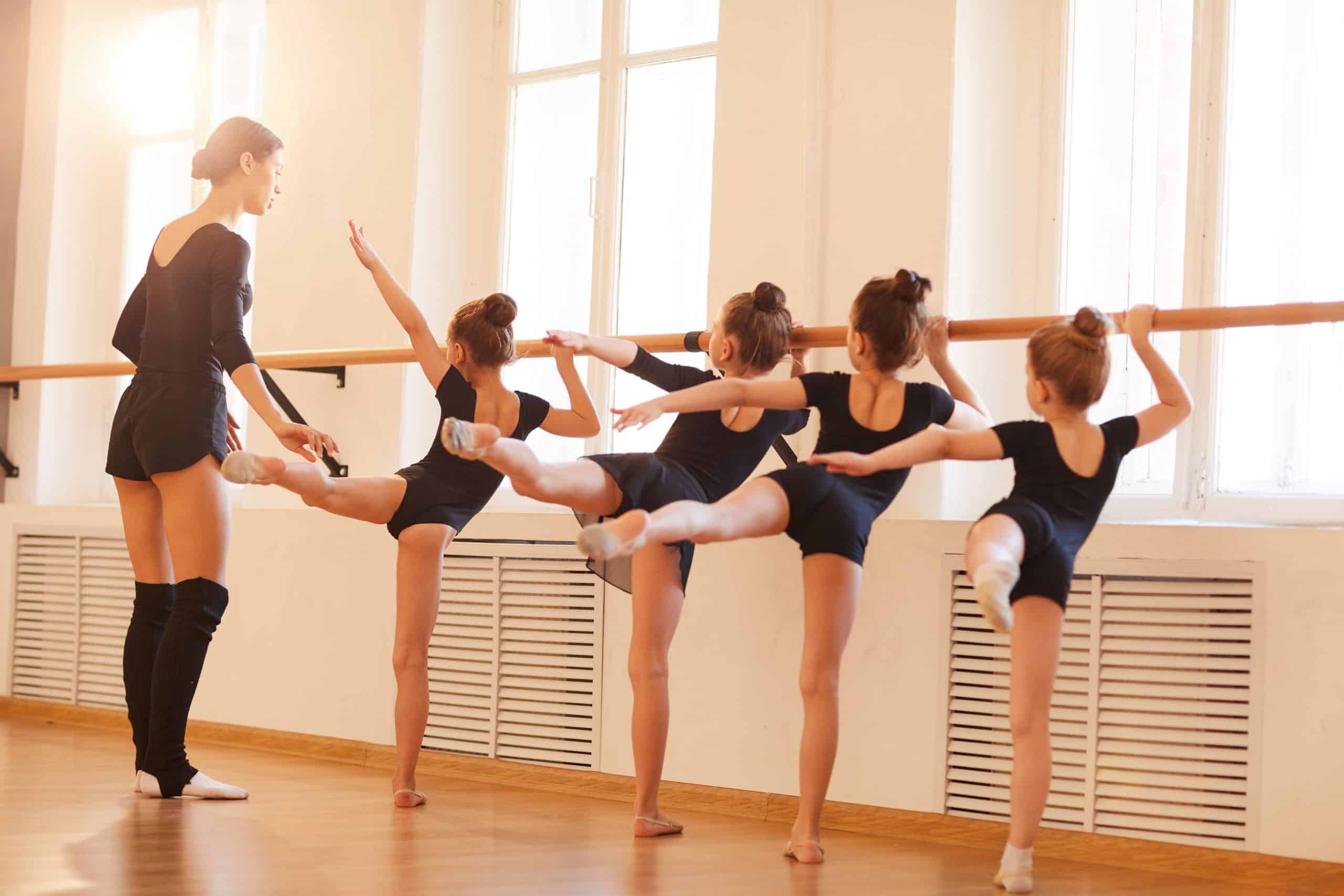Home>Events & Info>Ballet>How To Become A Ballet Teacher


Ballet
How To Become A Ballet Teacher
Modified: January 22, 2024
Learn how to become a ballet teacher and share your passion for ballet with others. Gain the necessary skills and knowledge to inspire future dancers.
(Many of the links in this article redirect to a specific reviewed product. Your purchase of these products through affiliate links helps to generate commission for AudioLover.com, at no extra cost. Learn more)
Table of Contents
Introduction
Welcome to the world of ballet teaching! Ballet is a timeless art form that requires dedication, discipline, and a deep understanding of technique and movement. As a ballet teacher, you have the incredible opportunity to share your knowledge and passion for the art with aspiring dancers of all ages.
Being a ballet teacher is not just about teaching steps and routines; it involves guiding students through their ballet journey, instilling a love for the art, and helping them discover their full potential. It is a role that requires a unique combination of technical expertise, patience, and the ability to inspire and motivate.
In this article, we will guide you through the steps to become a ballet teacher. From gaining ballet training and experience to obtaining certification and building a professional network, we will cover all aspects of your journey. Whether you are a seasoned dancer looking to transition into teaching or someone starting fresh, this guide will provide you with the necessary information to embark on your ballet teaching career.
Throughout the article, we will provide insights, tips, and recommendations based on industry standards and best practices. It’s important to note that becoming a ballet teacher is a unique process for each individual, and there may be variations or additional steps depending on your location and specific circumstances.
So, if you are ready to take the next step and share your love for ballet with future generations of dancers, let’s dive in and explore the path to becoming a ballet teacher!
Step 1: Gain Ballet Training and Experience
The first and essential step towards becoming a ballet teacher is to gain a strong foundation in ballet training and accumulate extensive experience as a dancer. Ballet is a highly technical and disciplined art form, and it requires a deep understanding of the movements, terminology, and principles that make up this beautiful dance style.
Start by enrolling in ballet classes at a reputable dance school or studio. Look for teachers who have a strong background in both performing and teaching ballet. They will be able to guide you through the fundamental techniques and help you develop proper posture, alignment, and strength.
It’s important to approach your ballet training with dedication and discipline. Attend classes regularly and diligently practice outside of class to refine your skills. As you progress, consider taking part in workshops, summer intensives, and ballet competitions to further challenge yourself and expand your repertoire.
Additionally, gaining performance experience is crucial in understanding the artistry and stage presence required in ballet. Seek opportunities to perform in recitals, showcases, or even local productions. The stage experience will not only enhance your technical abilities but will also help you develop your artistic expression and connection with the audience.
As you continue your ballet training and accumulate experience, strive to learn from a diverse range of teachers. Every teacher has a unique approach, and exposure to different teaching styles will broaden your knowledge and understanding of ballet. Take advantage of masterclasses and guest teachers whenever possible to further expand your horizons.
Remember, becoming a ballet teacher is a lifelong journey of learning and growth. Embrace every step of your training and use it as an opportunity to deepen your understanding of ballet. Your dedication and experience as a dancer will serve as the foundation for your future career as a ballet teacher.
Step 2: Complete Teacher Training Programs
Once you have established a strong foundation in ballet training and gained significant experience as a dancer, the next step is to enroll in teacher training programs specifically designed for ballet instructors. These programs will provide you with the necessary knowledge and skills to effectively teach ballet to students of various ages and skill levels.
Look for reputable teacher training programs that are recognized and accredited by dance education organizations or institutions. These programs typically offer comprehensive coursework that covers ballet pedagogy, anatomy, music for ballet, teaching methodology, and classroom management techniques.
Teacher training programs not only enhance your understanding of the technical aspects of ballet but also focus on developing your teaching skills and approaches. You will learn how to structure and plan ballet classes, create lesson plans, effectively communicate with students, and provide constructive feedback.
During these programs, you may also have the opportunity to observe experienced ballet teachers in action and participate in practical teaching exercises. This hands-on experience is invaluable as it allows you to apply the theories and techniques you have learned in a real classroom setting.
Another key aspect of teacher training programs is the opportunity to learn about different teaching methodologies and approaches. These programs expose you to a variety of teaching styles, helping you develop your teaching philosophy and finding your unique voice as a ballet instructor.
It is worth mentioning that teacher training programs may vary in duration and intensity. Some programs offer short-term certifications, while others provide more extensive courses that span several months or even years. Consider your personal preferences, schedule, and long-term goals when selecting a program that suits you best.
Upon completing a teacher training program, you will receive a certification or diploma, which validates your knowledge and qualification as a ballet teacher. This certification will not only boost your credibility but will also open doors to job opportunities in dance schools, studios, and other educational institutions.
Remember that teacher training programs should be seen as a starting point in your journey as a ballet instructor. Continuous learning and professional development will be essential throughout your teaching career to stay updated on the latest teaching techniques and methodologies.
Step 3: Obtain Certification
In the field of ballet teaching, obtaining certification is highly valued and can significantly enhance your professional credentials. Certification demonstrates your commitment to upholding a certain standard of teaching excellence and assures employers and students that you have the necessary knowledge and skills to deliver quality ballet instruction.
There are various certification programs available for ballet teachers, offered by reputable dance education organizations and associations. These programs typically require you to meet certain criteria, such as completing specific coursework, demonstrating teaching proficiency, and passing written and practical examinations.
Before pursuing a certification program, research different organizations and their certification requirements to find the one that aligns with your teaching goals and aspirations. Some organizations offer certifications specifically tailored to teaching ballet to young children or more advanced levels, so choose the one that suits your desired teaching focus.
Once you have chosen the certification program, you will need to complete the necessary requirements. This may involve attending workshops, seminars, or online courses, submitting teaching portfolios, and passing examinations that assess your knowledge and teaching abilities.
One of the benefits of obtaining certification is that it provides structure and guidance for your professional development as a ballet teacher. Certification programs often have ongoing educational requirements, encouraging you to continue expanding your knowledge and refining your teaching skills through continuing education courses, conferences, and workshops.
Having certification also increases your employability as a ballet teacher. Many dance schools, studios, and educational institutions prefer instructors who hold recognized certifications, as it assures them of your competency and dedication to the field. It can set you apart from other applicants and give you a competitive edge in the job market.
Moreover, being a certified ballet teacher opens up opportunities for collaboration and networking within the dance education community. You can connect with other certified teachers, attend conferences, and engage in professional development activities, further enhancing your teaching abilities and broadening your horizons.
Remember that certification is not a one-time accomplishment; it requires ongoing commitment to maintaining and updating your skills. Many certifications have renewal requirements, such as completing continuing education hours or attending refresher courses, to ensure that teachers stay current in their knowledge and teaching practices.
By obtaining certification, you demonstrate your dedication to the art of ballet teaching and position yourself as a qualified and competent professional in the field.
Step 4: Gain Teaching Experience
Teaching experience is an invaluable aspect of becoming a successful ballet teacher. It allows you to apply your knowledge and skills in a practical setting, refine your teaching methods, and develop a rapport with students. Building a solid foundation of teaching experience will not only strengthen your abilities as an instructor but also enhance your credibility within the dance community.
Start by seeking opportunities to assist experienced ballet teachers in their classes. Assisting allows you to observe different teaching styles, gain insights into classroom management techniques, and understand the dynamics of a ballet class. It also provides you with hands-on experience in working with students of various skill levels and age groups.
As you gain confidence and proficiency in assisting, you can gradually take on more responsibility and start teaching segments of the class under the guidance of the lead teacher. This gradual transition helps you build your teaching skills and prepares you for full-fledged teaching responsibilities.
In addition to assisting, consider offering private lessons or small group classes to gain further teaching experience. This allows you to tailor your instruction to the specific needs and goals of individual students, honing your ability to provide personalized guidance and support.
Look for opportunities to teach in different environments, such as community centers, schools, or dance studios. Each setting will present unique challenges and opportunities for growth as a teacher. Embrace the chance to work with diverse student populations and adapt your teaching approach accordingly.
Furthermore, volunteering to teach ballet workshops or summer intensives can provide you with concentrated teaching experience. These programs often attract students from various backgrounds and levels of experience, allowing you to further develop your teaching skills in a focused and intensive setting.
Reflect on your teaching experiences regularly. Analyze the effectiveness of your teaching methods and seek feedback from students and colleagues. Continuously strive to improve and refine your teaching techniques based on the feedback and observations you receive.
Consider recording your classes to review your teaching style and make necessary adjustments. This practice can help you identify areas of improvement, such as clarity of instruction, pacing, and demonstration technique.
Remember that teaching experience is an ongoing process. Each class you teach provides an opportunity for growth and learning, so embrace every chance to lead a ballet class. The more experience you accumulate, the more confident and effective you will become as a ballet teacher.
Step 5: Continuously Update Skills and Knowledge
As a ballet teacher, it is crucial to stay up-to-date with the latest trends, techniques, and research in the field. Ballet is an ever-evolving art form, and it is essential to continuously update your skills and knowledge to provide the best possible instruction to your students. Here are some key ways to ensure you stay current in your teaching practice:
Attend Workshops and Conferences: Participate in workshops and conferences that focus on ballet education. These events often feature renowned teachers, choreographers, and industry experts who share their insights and expertise. It is an excellent opportunity to learn new teaching techniques, explore current trends, and connect with other professionals in the dance community.
Take Continuing Education Courses: Seek out specialized courses or certifications that allow you to deepen your knowledge in specific areas of ballet instruction, such as teaching ballet to different age groups or teaching ballet as a therapeutic practice. Continuing education courses not only expand your teaching skills but also differentiate you as a well-rounded and knowledgeable ballet teacher.
Follow Current Ballet Publications and Research: Stay informed about the latest ballet publications, research studies, and articles that discuss advancements in teaching techniques, injury prevention, and dance science. This knowledge will help you incorporate evidence-based practices into your teaching and ensure the well-being of your students.
Engage in Self-study: Dedicate time to further your own ballet study. Continuously refine your technique, expand your repertoire knowledge, and explore different ballet styles. The more you immerse yourself in the art form, the richer your teaching will become.
Seek Feedback from Colleagues and Students: Regularly seek feedback from fellow ballet teachers, mentors, and even your students. They can provide valuable insights and suggestions for improvement. This feedback loop allows you to continuously grow and enhance your teaching skills.
Embrace Technology and Online Resources: Take advantage of technology and online platforms to supplement your learning. There are numerous online resources, instructional videos, and webinars available that can provide valuable insights and inspiration for your teaching practice.
Network with Other Dance Professionals: Connect and collaborate with other ballet teachers, dancers, and choreographers. Sharing experiences, ideas, and teaching strategies with others in the field will broaden your perspective and inspire innovation in your own teaching.
Remember, as a ballet teacher, you are not only a guide for your students but also a lifelong learner yourself. By continuously updating your skills and knowledge, you ensure that your teaching remains relevant, effective, and inspiring to generations of ballet dancers.
Step 6: Build a Professional Network
Building a strong professional network is essential for success as a ballet teacher. Your network not only provides support and guidance but also opens doors to opportunities, collaborations, and professional growth. Here are some key steps to help you build a robust network within the dance community:
Attend Dance Events and Workshops: Participate in dance events, workshops, and conferences where you can connect with fellow ballet teachers, choreographers, and dancers. These gatherings provide opportunities to network, exchange ideas, and learn from experienced professionals in the field.
Join Professional Organizations: Consider joining professional organizations dedicated to dance education, such as the International Association for Dance Medicine and Science (IADMS) or the National Dance Education Organization (NDEO). These organizations often offer networking events, resources, and forums where you can connect with like-minded individuals and stay updated on industry trends.
Engage in Social Media: Utilize social media platforms to connect with other ballet teachers and dance enthusiasts. Join online communities, follow relevant ballet-related accounts, and actively engage in discussions. Social media can be a powerful tool for networking, sharing ideas, and staying connected with the pulse of the dance community.
Collaborate with Local Dance Institutions: Reach out to local dance schools, studios, and performing arts organizations. Offer to guest teach a class, choreograph a piece, or participate in collaborative projects. Collaboration not only expands your network but also exposes you to different teaching environments and styles.
Mentorship and Apprenticeships: Seek out mentorship opportunities with experienced ballet teachers. Mentors can provide valuable guidance, share their knowledge, and offer insights into the teaching profession. Consider apprenticing with established teachers to gain practical experience and build professional relationships.
Engage in Outreach Programs: Volunteer to teach ballet classes or workshops in underserved communities or schools. Not only will you make a positive impact on young aspiring dancers, but you will also connect with other passionate individuals who share a common interest in promoting dance education.
Attend Continuing Education for Ballet Teachers: Participate in continuing education programs and training sessions specifically designed for ballet teachers. These opportunities allow you to network with fellow educators, exchange teaching methodologies, and form lasting connections.
Remember, building a professional network takes time, effort, and genuine engagement. Actively seek out opportunities to connect, share your expertise, and contribute to the dance community. By establishing a strong network of supportive colleagues and mentors, you will not only have a valuable support system but also open doors to exciting career prospects and collaborations in the world of ballet teaching.
Step 7: Start Teaching Ballet Classes
Congratulations! You have now reached the final step of your journey to become a ballet teacher. It’s time to put all your training, experience, and networking into action by officially starting to teach ballet classes. Here are some important considerations as you embark on this new phase:
Prepare Your Curriculum: Develop a curriculum for your ballet classes based on your training, expertise, and the level of your students. Plan the progression of exercises, techniques, and combinations to ensure a well-rounded and engaging learning experience. Tailor your curriculum to meet the specific needs and goals of your students.
Create a Positive Learning Environment: Foster a supportive and nurturing environment where students feel safe to take risks, express themselves, and explore their potential. Encourage open communication, provide constructive feedback, and inspire a love for ballet in your students.
Utilize Effective Teaching Methods: Use a variety of teaching techniques to cater to different learning styles and abilities. Incorporate visual demonstrations, verbal cues, and hands-on corrections to help students understand and execute ballet movements correctly.
Develop Classroom Management Skills: Establish clear expectations and rules for your ballet classes. Learn effective strategies for managing student behavior, maintaining discipline, and creating a focused learning environment. A well-managed classroom allows for maximum learning and development.
Adapt and Modify for Individual Students: Recognize that each student is unique and may require individualized attention and adaptations. Be attentive to their strengths, challenges, and learning pace. Offer modifications or alternative approaches to ensure inclusivity and foster progress in each student’s ballet journey.
Continuously Evaluate and Reflect: Regularly assess student progress and adjust your teaching methods accordingly. Reflect on each class, identifying areas for improvement and areas of success. Seek feedback from students, parents, and colleagues to better understand the effectiveness of your teaching techniques.
Stay Engaged in Professional Development: Continue to expand your knowledge and skills through professional development opportunities. Attend workshops, conferences, and seminars to stay abreast of the latest teaching techniques, industry trends, and research in ballet education.
Cultivate Relationships with Students and Parents: Build positive and respectful relationships with your students and their parents. Communicate regularly, provide progress updates, and address any concerns or questions promptly. Developing strong connections will help foster a supportive and dedicated ballet community.
Seek Opportunities for Growth and Visibility: Explore opportunities to showcase your students’ progress through recitals, performances, or competitions. These events not only provide a platform for students to showcase their skills but also increase your visibility as a ballet teacher.
Remember, the journey of a ballet teacher is a continuous learning process. Embrace every teaching experience, stay open to growth and feedback, and nurture your love for ballet. By sharing your passion, knowledge, and expertise, you have the power to inspire and shape the future generations of ballet dancers.
Conclusion
Congratulations on completing the steps to become a ballet teacher! You have embarked on a fulfilling journey of sharing your love for ballet with aspiring dancers and guiding them towards their dreams. Becoming a ballet teacher requires a solid foundation in ballet training, completion of teacher training programs, obtaining certification, gaining teaching experience, continuously updating your skills and knowledge, building a professional network, and finally, starting to teach ballet classes.
Remember that being a ballet teacher is not only about instructing students in the technical aspects of ballet, but also about nurturing their creativity, discipline, and passion for this beautiful art form. It’s a role that requires patience, empathy, and a genuine commitment to your students’ growth and development.
As you go forward in your ballet teaching career, continue to seek opportunities for professional growth and stay connected to the dance community. Engage in ongoing learning, attend workshops and conferences, and build relationships with fellow teachers, choreographers, and dancers. This network will support you, inspire you, and provide opportunities for collaboration and growth.
Remember that each student you teach is unique, with their own strengths, challenges, and aspirations. Tailor your instruction to meet their individual needs, and foster a safe and nurturing learning environment where they can flourish. Embrace the opportunity to continually reflect on your teaching methods, seek feedback, and adapt to the ever-evolving landscape of ballet education.
As a ballet teacher, you have the incredible privilege of playing a pivotal role in shaping the lives of your students. Through your guidance, passion, and expertise, you have the power to inspire them to reach their full potential and cultivate a lifelong love for ballet.
So, step into the studio, embrace the joy of teaching, and share your love for ballet with your students. Your dedication and commitment to this beautiful art form will make a lasting impact on the lives of those you teach, and the ballet community as a whole.











